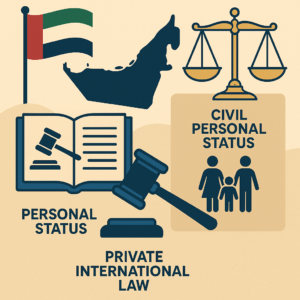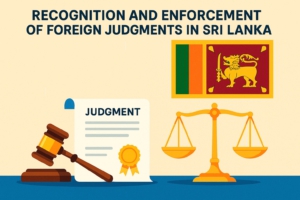 Prologue
Prologue
On 15 April 2025, the new federal UAE law on personal status (Federal Decree Law No 41 of 14 October 2024) officially entered into force ( “2024 PSL”). This law fully replaces the 2005 Federal Act on Personal Status (Federal Law No. 28 of 19 November 2005 as subsequently amended) (“2005 PSL”). The new law marks the latest step in the UAE remarkable wave of legal reforms, particularly regarding personal status matters. It follows a series of significant developments at both the federal and local levels. At the federal level, this includes the adoption of the law on Civil Personal Status (Federal Decree-Law No. 41 of 3 October 2022 on Civil Personal Status) (“2022 CPSL”) and its executive regulation. At the local level, specific legislations were adopted in the Emirate of Abu Dhabi, most notably the 2021 Law on Civil Marriages and its Effects (as subsequently amended) (“2021 ADCML”), and its Procedural Regulation. These legislative efforts collectively address what is commonly referred to as “civil family law” (for further details see previous posts on this blog here, here, here, and here). Together with the new 2024 PSL, these instruments will collectively be referred to as the “Family Law Regulations” (see Table below).
This overactive legislative activity has inevitably impacted on the articulation between the different legislative texts, both within the federal framework and between the federal and local levels. At the federal level, there is a need to consider the interaction between the 2024 PSL and the 2022 CPSL. At the intergovernmental level, this extends to the interplay between these two federal laws and the 2021 ADCML.
The icing on the cake – or perhaps the tipping point – is when private international law enters the equation. This is because the above family law regulations include provisions determining their scope of application, and in some cases allow for the application of foreign law under some conditions. This necessarily bring them into contact with the conflict of law rules contained in the 1985 Federal Act on Civil Transactions (Federal Law No. 5 of 21 March 1985, as subsequently amended) (“1985 FACT”).
Moreover, with the exception of the federal regulation on civil personal status, the other legislative texts also contain detailed rules on international jurisdiction. This leads to further interaction with the 2022 federal law on Civil Procedure (Federal Decree-Law No. 42 of 10 October 2022 on the Civil Procedure). This aspect, however, will not be addressed in this post. For a comparative overview of international jurisdiction in divorce matters, see my previous post here.
Table of relevant legislative texts:
(*) One of the unresolved questions is whether the 2022 CPSL also applies in Abu Dhabi—at least in a way that would override the provisions of the Abu Dhabi Law that are inconsistent with the federal legislation. This aspect is briefly addressed below.
It must be acknowledged that the current framework is highly complex, marked with multiple layers of interaction, and at times, inconsistencies and unresolved questions. The aim of this short post is simply to highlight these difficulties, particularly those relating to the scope of application and the interplay with choice of law rules, leaving a more-in-depth analysis for another occasion.
I. Innovations and clarifications
1. Scope of application
One of the most significant innovations introduced by the new 2024 PSL is its clear delineation of its scope of application, particularly in relation to the other foundational law, that is the 2022 CPSL. Indeed, the latter has already defined its scope by limiting its application to family law matters between non-Muslims, whether nationals or foreigners. Accordingly, it can be inferred that 2024 PSL limits its scope to family law matters involving Muslims. This is explicitly stated in respect of family relations involving UAE citizens. As for non-citizens, since family relations of foreign non-Muslims are primarily governed by the 2022 CPSL, the reference to “non-UAE citizen” in 2024 PSL should be understood as referring to “foreign Muslims”.
| 2024 PSL |
2022 CPSL |
| Art. 1 [Scope of Application]:
(1) The provisions of this Law shall apply to UAE citizens if both parties of the relationship or one of them is Muslim. |
Art. 1 [Scope of Application]:
(1) The provisions of this Decree-Law shall apply to non-Muslims who are national citizens of the United Arab Emirates, and to non-Muslim foreigners residing in the state […] |
| Art. 1 [Scope of Application]:
(3) The provisions of this Law shall apply to non-UAE citizens […] |
(*) All translations are based on the officially adopted versions, with modifications made where necessary. Own underlines and Italics.
2. Parties’ agreement
Another point worth highlighting is that both federal personal status laws contain provisions suggesting that a certain degree of party autonomy is permitted. However, the extent of this autonomy remains unclear. This issue will be discussed below.
| 2024 PSL |
2022 CPSL |
| Art. 1 [Scope of Application]:
(2) The provisions of this Law apply to non-Muslim UAE citizens unless […] they agree to apply another law permitted by the legislation in force in the State. |
Art. 1 [Scope of Application]:
(2) The persons governed by the provisions of this Decree-Law … may agree to apply other legislation regulating the family or personal status matters currently in force in the State instead of applying the provisions of this Decree-Law. |
| Art. 1 [Scope of Application]:
(3) The provisions of this Law shall apply to non-UAE citizens unless […] any other law that has been agreed to be applied, as permitted by the legislation in force in the State. |
3. Possibility of applying foreign law
Finally, like the 2022 CPSL and the now-repealed 2005 PSL, the 2024 PSL also allows for the application of foreign law. What is particularly noteworthy, however, is that the formulation originally found in the repealed 2005 PSL was not reproduced in the newly adopted 2024 PSL, despite its inclusion – albeit with some modifications – in the 2022 CPSL (see the underlined portion below). The reasons for this divergence remain unclear.
| 2024 Personal Status Law |
2022 Civil Personal Status Law |
| Art. 1 [Scope of Application]:
(3) The provisions of this Law shall apply to non-UAE citizens unless one of them invokes the application of his law [….] (*) |
Art. 1 [Scope of Application]:
(1) The provisions of this Decree-Law shall apply to non-Muslims who are national citizens of the United Arab Emirates, and to non-Muslim foreigners residing in the state, unless one of them invokes the application of his law, with regard to matters of marriage, divorce, successions, wills, and establishment of filiation, without prejudice to the provisions of Articles (12), (13), (15), (16), and (17) of the Federal Law No. (5) of 1985[on Civil Transactions] (**). |
(*) The Gender biased formulations found in the original texts are maintained.
(**) Art. 1(3) of the now-repealed 2005 PSL stated as follows: “The provisions of this Law shall apply to non-UAE citizens, unless one of them invokes the application of his law, without prejudice to the provisions of Articles (12), (13), (15), (16), (17), (27) and (28) of the Federal Law No. (5) of 1985 on Civil Transactions”.
The numbered articles concern respectively, conflict of law rules in matters of marriages (12), divorce (13), maintenance (15), guardianship and other institutions of protection of persons with limited capacity and absentees (16), successions and wills (17), as well as public policy (27) and failure to prove foreign law (28).
II. Ambiguities and persistent problems
1. Ambiguities
a) Scope of application
i) The 2021 ADCML and its 2022 Procedural Regulation
One of the most crucial points concerns the relationship between federal and local laws. As previously mentioned, the Emirate of Abu Dhabi took the initiative in 2021 by enacting its “Law on Civil Marriage and Its Effects”. This law – originally titled the “Personal Status Law of Non-Muslim Foreigners” – defined its scope of application in a more restrictive manner compared to the 2022 CPSL. While the latter applies to both foreign and local non-Muslims, the 2021 Abu Dhabi law was limited, as its title suggests, to foreign non-Muslim only.
| 2021 ADCML (before amendment) |
2022 CPSL |
| Art. 1 [Definitions]:
Foreigner: Any male or female non-Muslim foreigner, having a domicile, residence or place of work in the Emirate. |
Art. 1 [Scope of Application]:
(1) The provisions of this Decree-Law shall apply to non-Muslims who are national citizens of the United Arab Emirates, and to non-Muslim foreigners residing in the state […] |
| Civil Marriage: A union that is intended to be of indefinite duration according to the provisions of this Law, between a foreign man and woman, both non-Muslim. |
Only a few weeks after its adoption, the 2021 ADCML was amended. Notably, in addition to the change of the title as mentioned above, all references to “foreigners” and “foreign non-Muslims” were replaced with the more neutral phrase of “persons covered by the provisions of this law“. Moreover, new jurisdictional rules were adopted (Art. 17bis). Despite this amendment, and somewhat surprisingly, the amended law does not only define “persons covered by the provisions of this law” in an ambiguous manner (see some critical comments here), but also it continues to define civil marriage as union “between a foreign man and woman, both non-Muslim”. This has reinforced the impression that both the original law and its subsequent amendments were enacted without thorough consideration of their internal consistency or of the broader legal context in which they would operate.
| 2021 ADCML (after amendment) |
| Art. 1 [Definitions]:
Civil Marriage: A union that is intended to be of indefinite duration according to the provisions of this Law, between a foreign man and woman, both non-Muslim.
Persons covered by the provisions of this law: Foreigners and Nationals, non-Muslims, whether male or female. (*) |
(*) The original ambiguity in the formulation is maintained in purpose.
In 2022, a Procedural Regulation (“2022 Procedural Regulation”) was adopted with the intention of clarifying, inter alia, the scope and application of the 2021 ADCML. However, this instrument has introduced more inconsistencies and ambiguities than it has resolved. This is particularly evident with regard to the definition of “civil marriage”, as well as the ratione personae and ratione materiae of both the 2021 ADCML and its accompanying 2022 Procedural Regulation.
| Abu Dhabi 2021 Law (after amendment) |
The 2022 Procedural Regulation |
| Art. 1 [Definitions]:
Civil Marriage: A union that is intended to be of indefinite duration according to the provisions of this Law, between a foreign man and woman, both non-Muslim. |
Art. 1 [Definitions]:
Civil Marriage: Marriage that is concluded and registered under statutory laws and regulations, without taking into account of any particular religious law. |
| Persons covered by the provisions of this law: Foreigners and Nationals, non-Muslims, whether male or female |
Persons covered by the provisions of this law: Foreigners and non-Muslims Nationals, whether male or female |
| Article 5 (Persons covered by the provisions of this law):
The provisions of this law govern civil marriages and their effects, as well as all matters concerning the civil family according to the following cases:
1) Non-Muslim citizens
2) A foreigner who holds the nationality of a country that does not primarily apply rules of Islamis Sharia in matters of personal status […] In the case of multiple nationalities, the nationality to be taken into account shall be the one used based on the person’s status of residence in the State.
3) Where the marriage is concluded in a country that does not primarily apply rules of Islamic Sharia in matters of personal status [….]
4) Where the marriage is concluded in accordance with the provisions of civil marriage.
5) Any other case for which a decision is issued by the Head of the Department. |
Problems of interpretation and application generated by the ambiguities and inconsistencies of the 2021 ADCML and its 2022 Procedural Regulations have already been addressed on this blog (see here, here, and here). These issues particularly concern the application of these instruments to foreign Muslims, a possibility permitted under the 2021 ADCML and its 2022 Procedural Regulations as confirmed by recent case law, but not allowed under the 2022 CPSL.
ii) Constitutional implications
Given the differing scopes of application, a crucial issue has arisen: whether the 2022 CPSL overrides the local law in this respect. In other words, does the Federal Civil Personal Status Law also apply in Abu Dhabi?
From a constitutional perspective, the answer should be affirmative (see Article 151 of the Federal Constitution). However, the issue remains largely unresolved. In practice, lower courts in Abu Dhabi appear to give little weight to the federal law, applying the local law and its regulations instead. (The Abu Dhabi Supreme Court seems to follow a slightly different approach, as on some occasions it cited the 2022 Federal Law on Civil Personal Status. For examples, previous posts here, and here).
iii) Impact of the 2024 PSL
The situation, however, changes significantly with the adoption of the 2024 PSL. It is undisputed that this new federal law applies in Abu Dhabi as well. The absence of any local regulation on personal status (other than the 2021 ADCML and its 2022 Procedural Regulation) makes the application of the new federal law self-evident. Therefore, even if one were to argue (for the sake of discussion) that the 2022 CPSL does not apply in Abu Dhabi, it will still be necessary to observe how Abu Dhabi courts will reconcile the new law, which explicitly applies to Muslims (regardless of their nationality or whether their country of origin applies Islamic sharia in personal status matters), with the existing local regulations. A typical case would be a Muslim couple from Europe or elsewhere where Islamic Sharia does not primarily apply in matters of personal status, or Muslims from Muslim jurisdictions who got married under the 2021 ADCML, but then one of the parties claims the application of the 2024 PSL because they are Muslim, and therefore subject to the federal and not local law.
b) The Parties’ agreement
As mentioned above, both federal laws allow the parties to “agree” to apply “another law permitted by the legislation” (2024 PSL) or “other legislation regulating family or personal status matters” currently in force in the UAE (2022 CPSL). The formulations used here are highly problematic, as their exact meaning remains unclear.
For instance, it is unclear, whether the phrase “legislation in force” includes also local laws, notably the 2021 ADCML. Assuming that the 2022 CPSL does not override the 2021 ADCML, could parties residing in Dubai agree to apply it? This remains unresolved.
Moreover, an open question also concerns the form that such an agreement must take. Is an explicit agreement required, e.g., one that is formally recorded in the marriage contract? Or can consent be implied, such that a party’s reliance on the provisions of a given law is sufficient to infer tacit agreement?
Finally, and more importantly, it is not clear whether “non-UAE citizens” under the 2024 PSL, which applies primarily to Muslims (see above), would be allowed to choose the application non-Muslim law. While this can be somewhat “tolerated” in matters of marriage or divorce as the practice now in Abu Dhabi clearly shows (see previous post here, although the boundaries of such “tolerance” remains certainly unclear notably in other Emirates. From a broader perspective, see examples cited in Béligh Elbalti, “The Recognition and Enforcement of Foreign Filiation Judgments in Arab Countries”, in Nadjma Yassari et al. (eds.), Filiation and the Protection of Parentless Children (T.M.C. Asser Press, 2019), 397), such a possibility seems to be inconceivable in matters of successions, giving the longstanding position of UAE courts to consider that the Federal Personal Status Law – which is largely based on Islamic Sharia – should apply whenever one of the parties (the deceased or the heir) is Muslim (for detailed analyses and overview of applicable case law, see Béligh Elbalti, “Applicable Law in Succession Matters in the MENA Arab Jurisdictions – Special Focus on Interfaith Successions and Difference of Religion as Impediment to Inheritance”, 88(4) RabelsZ 2024 748, 751).
2. Persistent problems
Two are particularly relevant here, both concern (a) the applicability of foreign law, and (b) the interplay of the family law regulations with private international law.
a) Applicability of foreign law
A key difference between the 2021 ADCML and the 2022 CPSL (as well as the 2024 PSL) lies in the fact that the former excludes the very application of foreign law, rendering the 2021 ADCML directly and automatically applicable in all disputes that enter into its scope of application (it must be acknowledged, however, that a recent Abu Dhabi Supreme Court’s ruling suggests otherwise. Upon examination, though, the Court’s reference to choice of law rules does not have any tangible implication on the above stated conclusion). The only exception concerns matters of succession and wills, for which, a reference to choice of law rules is explicitly provided for within the law itself.
| 2021 ADCML (after amendment) |
2022 CPSL |
| Article 3 [Scope of Application] (*) (**):
(1) If the marriage is concluded in accordance with this law, it shall be the applicable law governing the effects of the marriage and its dissolution.
(2) This law shall apply to wills and succession matters concerning persons subject to its provisions, provided that the estate or the bequeathed property is located within the State. |
Art. 1 [Scope of Application]:
(1) The provisions of this Decree-Law shall apply to non-Muslims who are national citizens of the United Arab Emirates, and to non-Muslim foreigners residing in the state, unless one of them invokes the application of his law, with regard to matters of marriage, divorce, successions, wills, and establishment of filiation […] |
| Article 11 [Distribution of Estate]:
(3) Notwithstanding paragraph (2) of this Article [testate succession], any heir of the foreign deceased may request the application of the law governing the estate in accordance with the provisions of [1985 FACT], unless a registered will provides otherwise. |
Article 11 [Distribution of Estate]:
(3) Notwithstanding paragraph (2) of this Article [testate succession], any heir of the foreign deceased may request the application of the law governing the estate in accordance with the provisions of [1985 FACT], unless a registered will provides otherwise. |
(*) It is worth noting that article 3 in its original form was similar to that of Article of the 2022 CPSL. It stated as follows: “Unless the foreigner requests the application of their national law, the court shall apply this law to foreigners in matters relating to marriage, divorce, inheritance, wills, and the establishment of parentage.”
(**) See also Article 5 of the Procedural Regulation cited above.
This does not only give rise to problems of inconsistency with the federal personal status laws, but also with the 1985 FACT.
b) Interplay with choice of law rules
This is arguably the main issue that remains unresolved despite the various reforms and amendments. As mentioned above, the federal laws allow “one of the parties” to invoke the application of “his law”. Theoretically, if properly invoked, the foreign law would apply instead of the federal provisions. However, this possibility raises three core issues:
1) who is exactly meant by “one of the parties” (ahadihim)?
2) what is meant by “his law” (qanunihi), and
3) what is the current relevance of choice of law rules governing family matters as set out in the 1985 FACT?
i) Meaning of “one of the parties”
Regarding 1), there is a range of diverging opinions. For instance, the Explanatory Report of the now-repealed 2005 PSL referred to the “adversary party” (al-khasm). Certain strands in literature, contra legem, suggest that this concerns any party, but only when both of them share the same nationality. Case law, however, reveals more diverse scenarios: courts addressed the issue of the application of foreign law regardless of whether the parties hold the same nationality or not, and when the foreign is invoked by any of them. Yet, to the best of our knowledge, UAE courts have not provided a definitive answer to this question, often focusing instead on whether the party’s claim could be accepted or not.
ii) The Meaning of “his law”
Regarding 2), case law has largely clarified that “his law” refers to the lex patriae. Still, ambiguity remains in cases involving parties of different nationalities. Prior to 2020, the main connecting factor in matters of marriage and its dissolution was the lex patriae of the husband. It was thus unclear whether the wife could invoke the application of “her law” or whether she should claim the application of the lex patriae of her husband, when the latter based his claim on UAE law. In any case, where a party holds multiple nationalities, Article 24 (still in force) states that the lex fori (UAE law) shall apply.
However, in 2020, an amendment to the 1985 FACT introduced significant changes, shifting away from lex patriae as the main connecting factor in personal status. Particularly, articles 12 and 13 dealing respectively with marriage and its dissolution now refer to lex loci celebrationis. Moreover, Article 17 dealing with successions and wills grants considerable weight to professio juris, allowing a person in testate successions to designate the law that shall govern their estate. These changes have further deepened the discrepancy between the federal personal status regulations and the choice of law provisions contained in the 1985 FACT.
iii) Relevance of choice of law rules
Regarding 3), an as a result of what was stated above, resolving conflicts of law and coordinating the application of the various legislative instruments has become particularly difficult without significantly stretching the wording, and arguably, the intended meaning of the law. This difficulty is especially evident when the lex loci celebrationis differs from the parties’ lex patriae.
Article 1(2) of the 2022 CPSL offers somehow better articulation by including a two-part clause: “unless one of the parties invoke the application of his law, without prejudice to the provisions of Articles (12), (13), (15), (16), and (17)” of the 1985 FACT. Nevertheless, this articulation becomes problematic when both parties share the same nationality but have concluded their marriage abroad.
In any case, both laws remains silent on the consequences of the parties invoking his lex patriae when it conflicts with the law designated under the conflict of laws rules included in the 1985 FACT.
Epilogue
In practice, these theoretical complexities are often resolved in a far more radical and pragmatic way: foreign law is rarely applied, even when validly invoked by one or both parties.
It is against this backdrop that one can understand the rationale behind the adoption of civil family law regimes and the recent adoption of the 2024 PSL: rather than refining the existing conflict-of-law mechanisms, these instruments aim to sidestep them altogether by offering a self-contained and directly applicable alternative.




 Prologue
Prologue